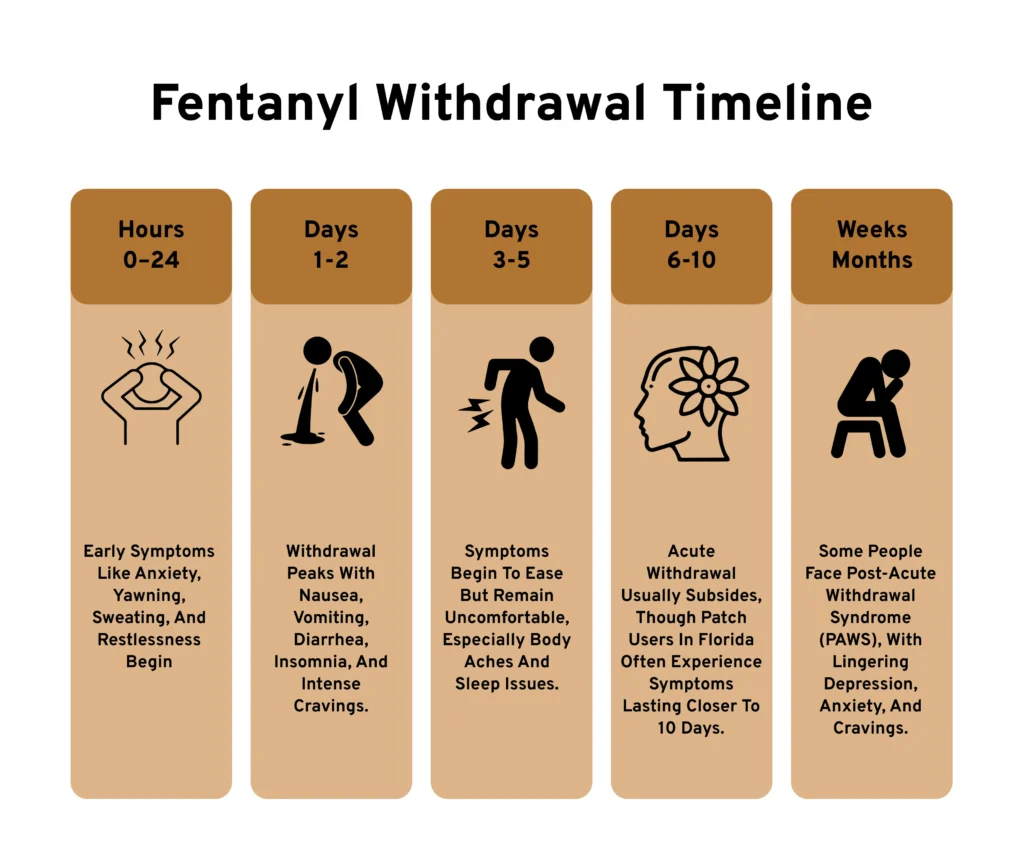Fentanyl is one of the most powerful opioids in the world, up to 100 times stronger than morphine. Across Florida, from Miami and Tampa to Palm Beach and Orlando, families are feeling the devastating effects of fentanyl addiction. Breaking free isn’t as simple as stopping use. The body and brain quickly become dependent, and withdrawal can be overwhelming without medical help.
That’s where fentanyl rehab in Florida becomes critical. Medically supervised detox centers provide safe withdrawal management, therapy, and long-term recovery planning. If you or a loved one is searching for answers, “When do fentanyl withdrawals start?” or “How long do fentanyl withdrawals last?”
Why is Fentanyl rehab critical?
Trying to quit fentanyl at home is not only painful but dangerous. Because fentanyl binds so strongly to the brain’s opioid receptors, withdrawal symptoms (add durgsrehabfl link for fentanyl withdrawal blog) can be severe and cravings intense.
In a detox center, patients receive round-the-clock medical monitoring to manage symptoms safely, along with Medication-Assisted Treatment (MAT) options like buprenorphine or methadone to ease withdrawal.
Therapies such as Cognitive Behavioral Therapy (CBT), Dialectical Behavior Therapy (DBT), and both group and family counseling are also part of the process, giving patients the tools to heal emotionally as well as physically.
Rehab programs further emphasize relapse prevention and aftercare planning, helping individuals prepare for lasting recovery beyond detox.
Without this professional support, the risk of relapse is high and with fentanyl’s strength, a single relapse can lead to overdose. Simply put, rehab saves lives.
When do Fentanyl withdrawals start?
Withdrawal doesn’t follow the same timeline for everyone, but most people begin to feel the first signs sooner than they expect. Withdrawal from short-acting or illicit fentanyl can begin within 2 to 12 hours after the last use. For those using a fentanyl patch, symptoms usually take longer to appear, often around 30 hours after the patch is removed.
What complicates matters even further is the environment. In Florida, where heat and humidity can affect how much fentanyl a patch delivers into the bloodstream, the withdrawal start time can vary widely. This means one person may begin to feel sick much sooner, while another might not notice symptoms until later, making the process unpredictable and overwhelming without support.
The first hours of withdrawal are often marked by restlessness, sweating, anxiety, and an overwhelming urge to use again just to make the discomfort stop. Without professional guidance, this is the point where many people relapse.
That’s why medical oversight in a detox center is so critical, it not only provides safety and comfort during those first painful hours but also gives individuals the confidence that they don’t have to go through the experience alone.
Fentanyl withdrawal timeline (day by day)
The fentanyl withdrawal process doesn’t look the same for everyone, but most people follow a general pattern once they stop using.
Understanding the withdrawal timeline can help individuals and families know what to expect and why medical support is so important. Symptoms typically start within hours of the last dose, build in intensity, and then gradually taper off over several days.
However, for those using fentanyl patches, especially in warmer climates like Florida, withdrawal can last longer and feel more unpredictable. Here’s a closer look at the day-by-day progression of fentanyl withdrawal

Medications and therapies for Fentanyl withdrawals
Detox is about far more than just waiting for Fentanyl withdrawal symptoms to pass. In Fentanyl Addiction treatment, recovery is made safer and more sustainable through a careful blend of Medication-Assisted Treatment (MAT) and therapy.
Medications like buprenorphine (Suboxone) are often used to ease withdrawal and cravings, with some centers using micro-induction to reduce the risk of precipitated withdrawal.
For individuals with severe opioid dependence, methadone may be prescribed, while other supportive medications such as clonidine or lofexidine, along with anti-nausea drugs and sleep aids, are used to target specific symptoms.
Equally important are the therapeutic interventions that accompany MAT. Evidence-based approaches like Cognitive Behavioral Therapy (CBT) and Dialectical Behavior Therapy (DBT) help patients reshape harmful thought patterns and develop healthier coping strategies.
Group and family therapy sessions provide emotional support and strengthen relationships, while relapse prevention planning equips individuals with tools to navigate life after detox.
Together, they transform detox from a painful process into the first solid step toward lasting recovery.
Fentanyl patch withdrawal symptoms
For people detoxing from fentanyl patches, withdrawal can feel like a marathon. Unlike other forms of fentanyl, the patch releases the drug slowly, which means symptoms often start later but can last longer. Many describe feelings of irritability, heavy sweating, stomach upset, and powerful cravings that seem impossible to fight.
Patch users may struggle with these symptoms for up to 10 days. In Florida, even the environment plays a role—heat and humidity can change how much fentanyl is absorbed through the skin, making withdrawal unpredictable. This is why medical supervision becomes so important: no one should have to face those long days and nights of discomfort and risk alone.
How long does it take to detox from Fentanyl
For most people, Fentanyl detox lasts between 3 and 10 days. But anyone who has lived through it will tell you—detox is only the beginning. Clearing fentanyl from the body is one step; learning how to live without it is another.
That’s why rehab programs emphasize ongoing care beyond detox, whether through inpatient rehab, outpatient therapy, or sober living homes. Recovery isn’t just about getting through a week of withdrawal, it’s about rebuilding a life that feels worth staying sober for.
Fentanyl detox centers in Florida: what to look for
When searching for fentanyl detox centers in Florida, families should consider:
- Accreditation by The Joint Commission or CARF
- 24/7 medical supervision and on-site MAT programs
- Levels of care: inpatient rehab, residential treatment, PHP, IOP
- Insurance acceptance (Medicare, Medicaid, private insurance plans in Florida)
- Aftercare and relapse prevention services
Cities like Miami, Tampa, Orlando, Palm Beach, and South Florida all host centers equipped to handle fentanyl rehab.
After detox: long term recovery
Detox clears fentanyl from the body, but true healing goes much deeper. The mind, body, and spirit need time and support to recover. That’s why Fentanyl rehab centers provide multiple levels of care designed to meet people where they are in their journey.
For those who need structure and safety, residential treatment programs create a secure environment to focus fully on recovery. Others may benefit from the flexibility of outpatient programs, where therapy and support fit alongside daily responsibilities.
To make sobriety sustainable, many centers also provide aftercare services and access to sober living homes, giving individuals a supportive community as they transition back into everyday life. Specialized programs are often available too, including tailored care for young adults, working professionals, and people facing polysubstance addiction. With therapies, peer support, and relapse prevention strategies, these programs help people build the skills they need for long-term sobriety.
Cost of fentanyl rehab
The cost of Fentanyl rehab in Florida depends on several factors, including the level of care, program length, and whether specialized services are included.
Many accredited rehab centers accept Medicaid, Medicare, and private insurance, which can significantly reduce out-of-pocket expenses. Some facilities also offer sliding scale fees or payment plans to make treatment more accessible.
The best way to understand your options is to contact a Florida rehab center directly and verify insurance coverage before starting treatment.
Battling drug addiction? You don’t have to face it alone.
What is fentanyl addiction?
Fentanyl addiction occurs when a person becomes physically and psychologically dependent on this powerful synthetic opioid. Because fentanyl is up to 100 times stronger than morphine, tolerance builds quickly, leading people to take higher doses. This increases the risk of overdose. Fentanyl rehab and medical detox are the safest ways to break the cycle of addiction and begin recovery.
Is drug rehab free in the US?
While not all drug rehab programs are free, there are options for low-cost or no-cost care. State-funded rehabs, nonprofit organizations, and programs that accept Medicaid or Medicare can provide affordable treatment. Many fentanyl detox centers in Florida and across the U.S. also accept private insurance, and some offer sliding-scale payment plans. Calling a treatment center directly is the best way to verify coverage and costs.
What country brings fentanyl to the USA?
According to the CDC and NIDA, fentanyl use and overdoses have sharply increased in the past decade. Synthetic opioids, primarily fentanyl, are now the leading cause of overdose deaths in the U.S. In states like Florida, this trend has been especially devastating, highlighting the critical need for detox centers, MAT, and long-term rehab options.
Is fentanyl an end-of-life drug?
Fentanyl does have medical uses, including in end-of-life care for patients with severe pain. It may be prescribed as a patch, lozenge, or injection under careful supervision. However, outside of these settings, misuse of fentanyl is extremely dangerous due to its potency and high risk of addiction.
How long does fentanyl stay in your system?
Fentanyl can remain in the body for 24 to 72 hours, depending on the form used (patch, pill, or illicit fentanyl) and the individual’s metabolism. In drug tests, fentanyl may be detected in urine for up to 3 days, in saliva for 1–2 days, and in hair for up to 90 days. This variability is one reason why professional detox is recommended, as the drug’s lingering presence can prolong withdrawal symptoms and cravings


